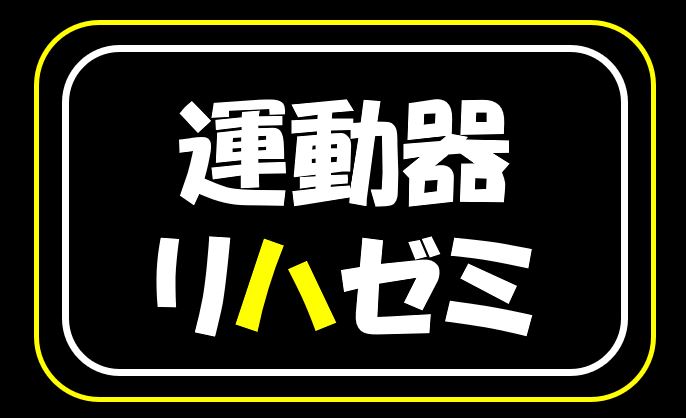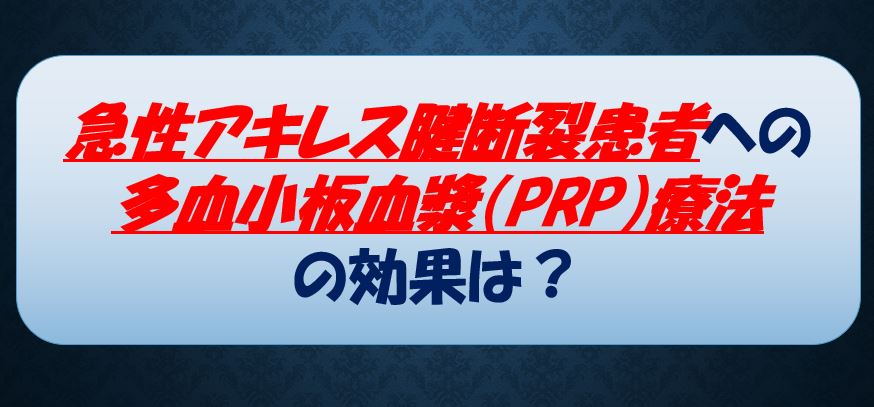こんにちは!
運動器専門のリハビリスタッフです!!
いつもお世話になります。
今回は、『急性アキレス腱断裂患者への多血小板血漿(PRP)療法の効果は?』について解説させていただきます。
『アキレス腱断裂を予防する方法とは(アキレス腱断裂 診療ガイドライン2019より)』
アキレス腱は人体の中で最大で最強の腱ですが、アキレス腱断裂は非常に発生頻度の高いスポーツ外傷として報告されています。
治療法に関しては手術療法、保存療法ともに成績良好と言われています。
アキレス腱断裂はプロスポーツ選手から、一般のレクリエーションスポーツレベルの方まで生じる外傷であります。
◆アキレス腱断裂をした有名スポーツ選手
●川口能活(サッカー/36歳で断裂)
●デビット・ベッカム(サッカー/34歳で断裂)
●西岡剛(野球/31歳で断裂)
●伊達公子(テニス/31歳で断裂)
●コービー・ブライアント(バスケットボール/34歳で断裂)
そんな中、2019年に、急性アキレス腱断裂に対して多血小板血漿(PRP:platelet-rich plasma)療法の効果があるのかを検証した論文が海外で報告されております。
この論文の検証結果がとても気になるところです。
◆PRP療法とは
PRP療法とは自分の血液を採取し、特殊な技術を駆使して、血液中の血小板が多く含まれる部分のみを抽出して、PRP(多血小板血漿)を作成します。そして、自分の傷んでいる部位に注射することで早期治癒を図ります。
早期の競技復帰のために、PRP療法を行っているプロスポーツ選手なども多くいらっしゃいます。
ヨーロッパやアメリカでは、自己治癒力をサポートする治療として頻繁に行われているようです。
現時点(2022年3月)で多血小板血漿(PRP)療法は自費診療ですので、少し治療費は高くなります。
◆論文紹介
Randomized Controlled Trial
BMJ (IF: 30.22; Q1)
. 2019 Nov 20;367:l6132.
doi: 10.1136/bmj.l6132.
Platelet rich plasma injection for acute Achilles tendon rupture: PATH-2 randomised, placebo controlled, superiority trial
急性アキレス腱断裂に対する多血小板血漿(PRP)注入療法。PATH-2無作為化プラセボ対照優越性試験
David J Keene 1, Joseph Alsousou 2, Paul Harrison 3, Philippa Hulley 4, Susan Wagland 5, Scott R Parsons 5, Jacqueline Y Thompson 5, Heather M O’Connor 6, Michael Maia Schlüssel 6, Susan J Dutton 6, Sarah E Lamb 5 6, Keith Willett 5, PATH-2 trial group
Affiliations expand
- PMID: 31748208 PMCID: PMC6863552 DOI: 10.1136/bmj.l6132
Abstract
Objective: To determine whether an injection of platelet rich plasma improves outcomes after acute Achilles tendon rupture.
概要
目的 急性アキレス腱断裂後、多血小板血漿の注入が転帰を改善するかどうかを判断する。
Design: Randomised, placebo controlled, two arm, parallel group, participant and assessor masked, superiority trial.
デザイン 無作為化、プラセボ対照、2群並行、参加者・評価者マスク、優越性試験。
Setting: Secondary care trauma units across 19 hospitals in the United Kingdom’s health service.
設定 英国医療サービスにおける19病院の二次医療外傷ユニット。
Participants: Recruitment commenced in July 2015 and follow-up was completed in March 2018. 230 adults aged 18 years and over were included, with acute Achilles tendon rupture presenting within 12 days of injury and managed with non-surgical treatment. Exclusions were injury at the insertion or musculotendinous junction, major leg injury or deformity, diabetes mellitus, platelet or haematological disorder, systemic corticosteroids, anticoagulation treatment, and other contraindicating conditions.
参加者 2015年7月に募集を開始し、2018年3月にフォローアップを完了した。受傷後12日以内に発症し、非外科的治療で管理された急性アキレス腱断裂を有する18歳以上の成人230名が対象となった。除外項目は、挿入部または筋腱接合部の損傷、大きな脚の損傷または変形、糖尿病、血小板または血液疾患、全身性コルチコステロイド、抗凝固治療、およびその他の禁忌となる状態であった。
Interventions: Participants were randomised 1:1 to platelet rich plasma (n=114) or placebo (dry needle; n=116) injection. All participants received standard rehabilitation care (ankle immobilisation followed by physiotherapy).
介入 参加者は、多血小板血漿(PRP)(n=114)またはプラセボ(ドライニードル、n=116)注射に1対1で無作為に割り付けられた。参加者は全員、標準的なリハビリテーションケア(足首の固定と理学療法)を受けた。
Main outcomes and measures: Primary outcome was muscle tendon function at 24 weeks, measured objectively with the limb symmetry index (injured/uninjured×100) in maximal work done during the heel rise endurance test (an instrumented measure of repeated single leg heel rises until fatigue). Secondary outcomes included patient reported function (Achilles tendon rupture score), quality of life (short form 12 version 2®), pain (visual analogue scale), goal attainment (patient specific functional scale), and adverse events. A central laboratory analysed the quality and content of platelet rich plasma. Analyses were by modified intention to treat.
主なアウトカムと測定方法 主要アウトカムは24週時点の筋腱機能で、踵上げ耐久試験(疲労するまで片足で踵上げを繰り返す機器による測定)の最大作業における四肢対称指数(損傷/非損傷×100)で客観的に測定した。副次的評価項目は、患者報告機能(アキレス腱断裂スコア)、QOL(short form 12 version 2®)、疼痛(visual analogue scale)、目標達成度(患者別機能尺度)、有害事象である。中央検査室では、多血小板血漿(PRP)の品質と含有量を分析した。解析は修正intention to treatで行われた。
Results: Participants were 46 years old on average, and 57 (25%) of 230 were female. At 24 weeks, 202 (88%) participants completed the heel rise endurance test and 216 (94%) the patient reported outcomes. The platelet rich plasma was of good quality, with expected growth factor content. No difference was detected in muscle tendon function between participants receiving platelet rich plasma injections and those receiving placebo injections (limb symmetry index, mean 34.7% (standard deviation 17.7%) v 38.5% (22.8%); adjusted mean difference -3.9% (95% confidence interval -10.5% to 2.7%)) or in any secondary outcomes or adverse event rates. Complier average causal effect analyses gave similar findings.
結果 参加者の平均年齢は46歳で、230人中57人(25%)が女性であった。24週目には、202名(88%)が踵上げ耐久試験、216名(94%)が患者報告アウトカムを完了した。多血小板血漿(PRP)は品質が良く、成長因子の含有量も期待された。多血小板血漿(PRP)注射を受けた参加者とプラセボ注射を受けた参加者の間で筋腱機能に差は検出されず(四肢対称指数、平均34.7%(標準偏差17.7%)対 38.5%(22.8%); 調整後平均差-3.9%(95%信頼区間-10.5%~2.7%))、副次的転帰や有害事象率にも違いはなかった。コンプライヤー平均の因果関係解析でも同様の結果が得られた。
◆論文の結論
Conclusions: There is no evidence to indicate that injections of platelet rich plasma can improve objective muscle tendon function, patient reported function, or quality of life after acute Achilles tendon rupture compared with placebo, or that they offer any patient benefit.
結論 多血小板血漿の注入が、プラセボと比較して、急性アキレス腱断裂後の客観的筋腱機能、患者報告機能、QOLを改善すること、また患者の利益をもたらすことを示す根拠はな
い。
◆まとめ
上記論文では受傷後12日以内の急性アキレス腱断裂(保存療法)を有する18歳以上の成人230名(平均46歳、男性173名、女性57名)に対して、多血小板血漿(PRP)療法群114名、プラセボ群116名の2群に分けて効果を比較しております。
治療24週時に踵上げ耐久試験、アキレス腱断裂スコア、QOL(short form 12 version 2®)、疼痛(visual analogue scale)、目標達成度(患者別機能尺度)、有害事象を評価しているそうです。
その結果、多血小板血漿(PRP)療法群とプラセボ群の間で筋腱機能に有意差は差はなく、その他の評価項目においても差はなかったそうです。
上記論文の結果から考えると、多血小板血漿(PRP)療法は、様々な外傷や障害に適応されていますが、急性アキレス腱断裂においては、効果は乏しいようです。
今回は、『急性アキレス腱断裂患者への多血小板血漿(PRP)療法の効果は?』について解説させていただきました。



